Forum Replies Created
-
AuthorPosts
-
 Robin LeadbeaterParticipant
Robin LeadbeaterParticipantHi Mike,
Yep definitely a little orange image of the comet complete with tail in the spectrum there.
 Robin LeadbeaterParticipant
Robin LeadbeaterParticipantHi Nick,
The sodium emission is so intense in the spectrum that I wonder if there is any sign of a sodium tail like in Hale Bopp? I hope to take a spectrum of a cross section through the tails if the weather cooperates but a narrow band image though an Na D pass filter could be interesting. Not a common filter among amateurs though I guess. The inverse filter response is more common !
Robin
 Robin LeadbeaterParticipant
Robin LeadbeaterParticipantThis is what the spectrum in the region near the Na D lines looked like tonight at ~1A resolution. (The inset is the guider image showing the position of the slit). Note the Doppler blue-shift in the comet Na D lines relative to the sky lines
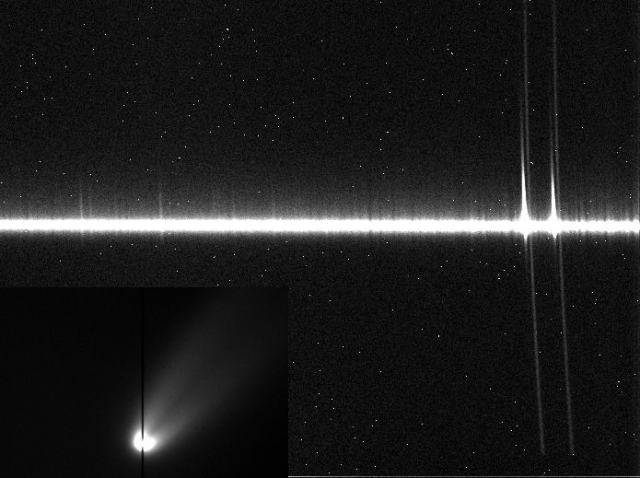
Robin
 Robin LeadbeaterParticipant
Robin LeadbeaterParticipantNot visible for a few days yet from the observatory so I rigged up a portable setup last night using a Star Analyser in front of a 50mm lens on an AS120mm camera, normally used as a guide camera on the ALPY spectrograph.
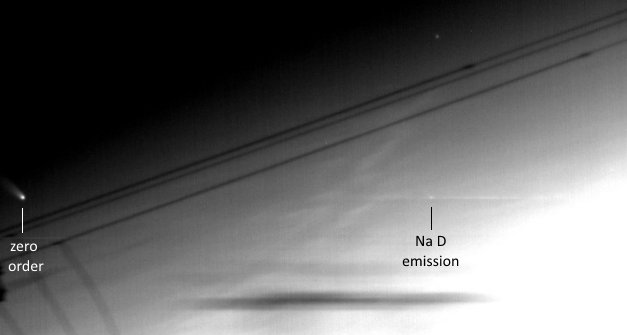
There is not much contrast between the spectrum and the bright sky but the sodium emission is clear.
Cheers
Robin
 Robin LeadbeaterParticipant
Robin LeadbeaterParticipantWow. the animated sequence linked from there showing it rising out of the clouds is pretty stunning
 Robin LeadbeaterParticipant
Robin LeadbeaterParticipantNow also confirmed as a Ia and so could reach mag 12 or perhaps even a bit brighter at this distance depending on extinction
 Robin LeadbeaterParticipant
Robin LeadbeaterParticipantI see there is a non detection by Koichi Itagaki at >mag 18.5 20200624.570 just 16 hours before the ATLAS discovery so definitely young
https://www.flickr.com/photos/snimages/50048748781/
his latest estimate 20200626.514 is 16.1 C
 Robin LeadbeaterParticipant
Robin LeadbeaterParticipantHi Kevin,
Glad to hear you have cracked it
Yes the light tightness of the LHIRES leaves much to be desired ! I know several owners (me and Jack on here for example) supplement the tape with a lightproof hood over the whole thing (keeping the cameras outside for air flow)
Cheers
Robin
 Robin LeadbeaterParticipant
Robin LeadbeaterParticipantAnother (marginal) observation of the Zeeman effect by Buil at R~30000. Also of doppler broadening/profile distortion due the to Evershed effect
 Robin LeadbeaterParticipant
Robin LeadbeaterParticipantIndeed. The splitting in the solar spectrum needs much higher resolution than the ALPY. It seems it is possible though with a LHIRES stopped down and using a very narrow slit giving ~R=43,000 (Christian Buil, near the bottom of the page)
http://www.astrosurf.com/buil/polar3/index.html
Cheers
Robin
 Robin LeadbeaterParticipant
Robin LeadbeaterParticipantNow classified as a Ia but the classifiers suggest it could be a subluminous supernova around/post maximum light rather than caught early.
https://wis-tns.weizmann.ac.il/object/2020nlb
It seems odd in that case though that it was not visible to ATLAS 2 days previously
https://wis-tns.weizmann.ac.il/astronotes/astronote/2020-126
(hopefully link not mangled this time !)
 Robin LeadbeaterParticipant
Robin LeadbeaterParticipantHi Keith,
I don’t know what version of Demetra you have but I see Shelyak have just (19th June) brought out a version specifically including support for the LISA
https://www.shelyak.com/logiciel-demetra/?lang=en
https://www.shelyak.com/wp-content/uploads/20200619-ChangeLog.pdf
Robin
 Robin LeadbeaterParticipant
Robin LeadbeaterParticipant– Calibration – still having problems in getting Demetra to ‘automatically’ recognize the calibration image and to properly assign the right spectral line. When I use ‘automatic’ I cannot get better than 2.4 RMS, where if I go in an manually set the lines to the image (5852, 6562, 6965, 7067, 7383) my calibration gets a very good .2-.8 RMS.
Yes these automatic systems tend to either work or fail catastrophically. (I often tell the tale from my other life in paper technology where we had developed a sensor which used a neural network to measure a property using the NIR spectrum. It was trained on a range of products and worked flawlessly….. until one day it started producing compete nonsense. It turned out the manufacturer of one of the materials used in the paper had made a subtle change in the formulation which he had not told us about !)
I can’t help with Demetra, though at Francois Cochard’s zoom workshop meeting on calibration, I did promise to try it!
https://www.youtube.com/watch?v=vijEMrow0hQ
(ISIS has an automatic function which works flawlessly for me with my ALPY and LHIRES, though unlke Demetra it does need some manual input to tune it initially and you need to point it to the approximate position of one line, then it can find them all)
Cheers
Robin
 Robin LeadbeaterParticipant
Robin LeadbeaterParticipantWell the sensor would not have much sensitivity that far into the IR but the star in question is the bright (V mag 6.6) star V419 Cep / HD203380. It is spectral class M2i which will be about 3x brighter at 1000nm compared with in the visual so pretty bright where the filter is transparent.
Robin
 Robin LeadbeaterParticipant
Robin LeadbeaterParticipantAs here for example
http://www.astrosurf.com/buil/filters/curves.htm#Astronomik%20Visual%20OIII
OK for visual use but most of these would need an IR block with a CCD camera
Robin
 Robin LeadbeaterParticipant
Robin LeadbeaterParticipantHi David,
That was my first thought but this is reported to be a narrow band image in [OIII]. Though perhaps it is possible that the filter leaks in the IR?
Cheers
Robin
 Robin LeadbeaterParticipant
Robin LeadbeaterParticipantHi Keith,
David mentioned MILES stars. I find a good way of checking the quality of ones observations is to measure a few of these stars and compare the results directly with the spectra as measured professionally. Any differences can then be investigated and once they are close to the professional version one can confidently submit spectra of other targets to the BAA database for example. You can see an example of this sort of test here using the ALPY 600.
https://britastro.org/node/8153
and there are more examples and further information here on my website
http://www.threehillsobservatory.co.uk/astro/spectroscopy_21.htm
Cheers
Robin
 Robin LeadbeaterParticipant
Robin LeadbeaterParticipantHi Hugh,
Time to place our bets on which way it will go next season !
A comment from Paul Roche in January:-
“It’s not obvious what’s going on here, as the declining EWs for H alpha and HeI suggest a diminishing disc, but the AAVSO photometry seems to suggest the opposite. We’ll have to keep an eye on things for the rest of the “X Per season” and see if it makes sense when we have a bit more data. It will be interesting to see how the (B-V) and (V-R) colour of the system is behaving, that might reveal a little more about the state of the disc”
There is very little data in other bands in the AAVSO photometry data. Does your continuum data show any colour trends ?
Cheers
Robin
 Robin LeadbeaterParticipant
Robin LeadbeaterParticipantThere are now over 230 spectra in the BAA spectroscopic database. Thanks to all contributors ! Continuing monitoring on a nominal 2 week basis during the next season is requested. The following is a quick analysis of a selection of the available spectra.
The fall in EW of both the H alpha and He 6680 lines plateaued during January 2020 and remained constant up to the last recorded spectra on 2020-04-06 so there was no complete loss of the disc, though the He line in particular became very weak at just -0.4A EW
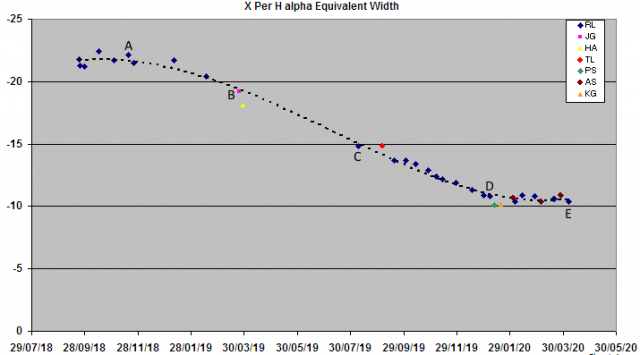
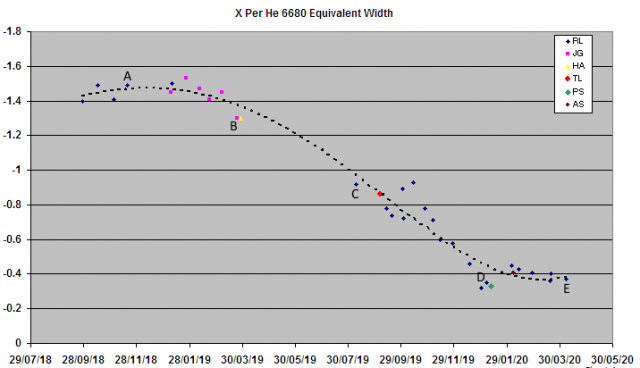
A snapshot of 5 heliocentric corrected line profiles during the monitoring period (marked A-E on the EW plots) shows the complex evolution of the lines and although the EW was approximately constant from Jan to April 2020, the line shape continued to evolve.
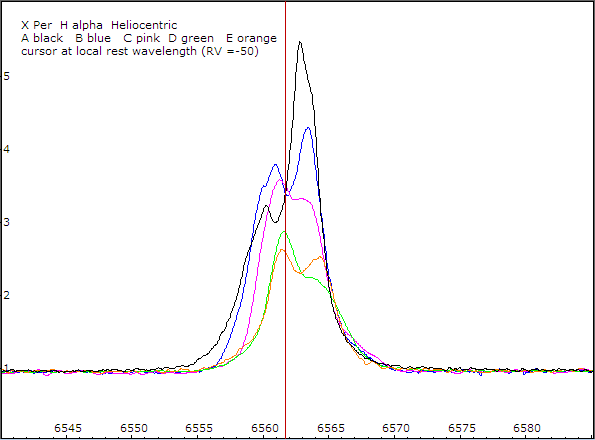
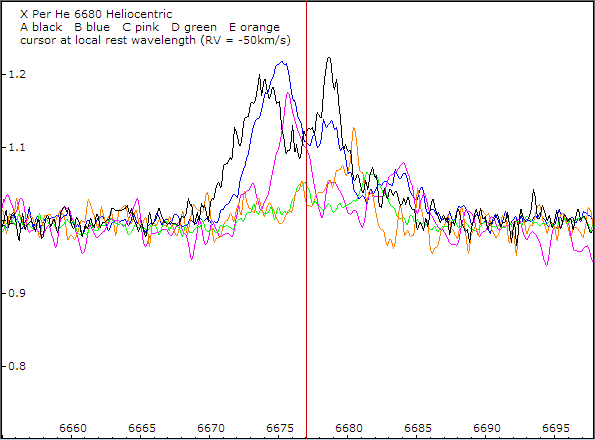
Although noisy due to the weakness of the line, there are significant differences in the He 6680 line profile compared with the H alpha line with higher radial velocity features particularly on the red edge.
Here is the AAVSO V mag light curve for the same period. There is no obvious correlation
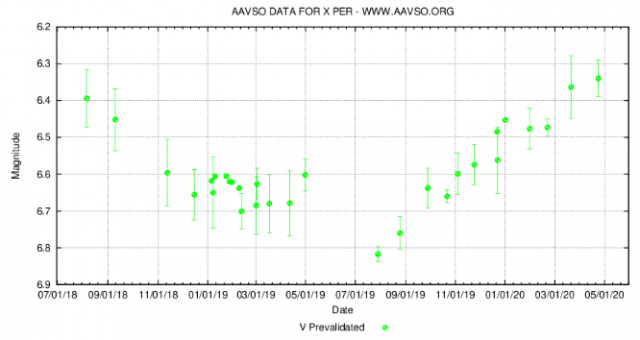
Cheers
Robin
 Robin LeadbeaterParticipant
Robin LeadbeaterParticipantThe same would apply if using the G channel from a DSLR to estimate the V mag of the nova as the G channel response at H alpha is different again eg
http://www.astrosurf.com/buil/50d/test.htm
Robin
-
AuthorPosts
